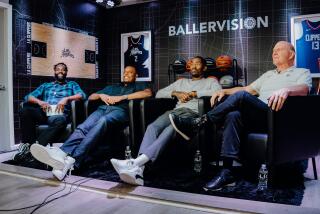Technology Brings Instant Replay to the Hockey Bench
- Share via
WASHINGTON — The shift is over on the power play, and Adam Oates skates to the controlled chaos of the bench.
Within seconds of sitting down, the Washington Capitals’ captain is looking over his shoulder at a black box about the size of a 2-pound chocolate sampler.
Assistant coach Tim Army is holding the box, and he’s touching a screen to activate a replay of what happened on the ice a minute or so earlier.
Instant replay just got more instant.
“At first, you’re kind of like, ‘What is this toy on the bench?’ Oates said. “But it’s good, it’s very effective.”
Already a forward-thinking organization when it comes to high-tech, the Capitals have a new gadget this season. It’s a video monitor called an XOSketch--a play on the name of the old Etch-a-Sketch toy--and it essentially uses the same new technology that allows a viewer to pause live action on television.
Washington is the only team to use the technology, which is a long way from the days of Gordie Howe and the image of hockey as a sport of brawn.
Even so, tough guys don’t like to be put in their place so quickly and dispassionately when coming off the ice, so the concept of replay on the bench has to be handled reasonably--and diplomatically.
“There’s been a pretty good reception from our players,” Army said. “At first, I was a little skeptical how they would respond to it. We don’t overuse it. We don’t use it negatively. It’s not, ‘See, you weren’t there.’ It’s not there to berate a player. It’s used just to teach and play a better game.”
The monitor is a high-tech version of the Polaroids that for years have been sent down to players on the sidelines during football games.
NFL teams will have to stay with the photographs for now, however, because of a rule that prohibits video on the sidelines or even in the locker room during a game.
It’s not surprising that the Capitals are the first to give the new monitor a try. Head coach Ron Wilson has been using computers for a decade and writes his own programs. The team is owned by AOL Time Warner executive Ted Leonsis, who gave a laptop and an Internet account to each player after buying the team two years ago.
“It’s a great teaching tool to have that kind of technology,” Wilson said. “It’s certainly a plus to have an owner who is not afraid of technology.”
But how much does it help? Neither Army nor any of several players could cite a tangible payoff--a moment this season in which a goal or big play was made as a result of something pointed out on the screen.
“It’s helped in general,” Army said. “Hockey’s different because it’s not a set game like football, where you have a new play every time starting at the line of scrimmage. I think it’s been good because it’s been illustrative of what we’re trying to do as a team. Sometimes players see things from their own perspective. There are times in the game when they can’t see things develop around them.”
Oates, one of the best passers in the league, said the monitor has been most useful on power plays.
“Sometimes the game’s so fast, you can’t recognize things,” Oates said. “You think a guy’s open, but he’s not. Or you think a guy’s covered, but he’s open. Sometimes just seeing it--you kind of go, ‘Wow! The guy is open.’ It’s a great visual aid.”
Because the bench is such a hectic place, Army has only 10 seconds or so to show a replay and get the point across.
He uses the monitor about eight times a game and only during the second period. The monitor is out of his reach during the first and third periods when he’s standing at the other end of the bench, a logistical flaw the team hopes to sort out later.
But it seems the player who might benefit the most from a quick replay isn’t there to see it. Goalkeeper Olaf Kolzig doesn’t make regular trips to the bench.
And besides, said Kolzig, all he has to do is look up.
“I’ve got the JumboTron,” Kolzig said. “I know when I’ve made a mistake.”
More to Read
Go beyond the scoreboard
Get the latest on L.A.'s teams in the daily Sports Report newsletter.
You may occasionally receive promotional content from the Los Angeles Times.










